Observer Name
UAC Staff
Observation Date
Monday, December 16, 2019
Avalanche Date
Sunday, December 15, 2019
Region
Salt Lake » Park City Ridgeline » Dutch Draw
Location Name or Route
Dutch Draw
Elevation
9,700'
Aspect
East
Slope Angle
40°
Trigger
Snowboarder
Trigger: additional info
Unintentionally Triggered
Avalanche Type
Soft Slab
Avalanche Problem
New Snow
Depth
2'
Width
100'
Vertical
400'
Caught
1
Carried
1
Buried - Partly
1
Buried - Fully
1
Killed
1
Accident and Rescue Summary
Summary
A 45-year-old male snowboarder, Matt Tauszik, was killed in an avalanche in Dutch Draw off of Silver Peak on a slope called Conehead. He was alone and did not carry any avalanche rescue gear. Because he was alone, we do not know all the events leading up to the avalanche. What we do know is that he was riding in the Canyons Village area of Park City Mountain Resort with his wife and son prior to the avalanche. He left them and rode the 9990 chairlift. At the top of the chairlift, he most likely accessed the Dutch Draw area via the backcountry exit gate. From this gate, there is a short descent along the ridgeline to the south followed by a hike up the same ridgeline to the top of Silver Peak.
Photo below shows the exit gate, the line of descent, and burial location (photo - Park City Ski Patrol). Notice tracks to the north (right) from other people riding that day.

Based on his tracks in the snow, Matt began his descent near the top of Silver Peak. Other people previously descended open terrain just to the north without incident. He rode the initial 100 vertical feet off the peak on an open slope before descending into a stand of trees for another 150 vertical feet. Near the bottom of the trees, he made a right-hand turn and jumped off a small rock. Upon landing or just after landing, he triggered the avalanche.
Photo below shows tracks starting near the top of Silver Peak (photo - UAC).

Photo below shows his tracks where he jumped a small rock and entered the slope that slid (photo - Park City Ski Patrol)

Rescue
Members of the public spotted the avalanche and converged on the debris where they spotted part of his snowboard sticking out of the snow. He was buried a maximum of three feet deep. The Park City Ski Patrol spotted the avalanche at about the same time and began preparations with the Summit County Sheriff's Office to respond. When they arrived, the public had dug Matt out of the snow and begun CPR. Ski patrollers continued CPR and transported him by toboggan to an ambulance parked near the bottom of the 9990 chairlift. He was transported to the Park City Hospital.
Based on interviews with the public, radio traffic, and calls to 911 and ski patrol dispatch; the best estimate is that he was buried for about 35 minutes. Responders reported obvious trauma. They also noted significant damage to his snowboard.
The Park City Ski Patrol searched the debris for signs of any additional burials. They did a quick search with avalanche transceivers and did not detect any signals. They also interviewed members of the public and counted ski tracks on the slope to determine that no one else was caught. There was only one set of tracks entering the avalanche.
Photo below taken from burial location (photo - Park City Ski Patrol).
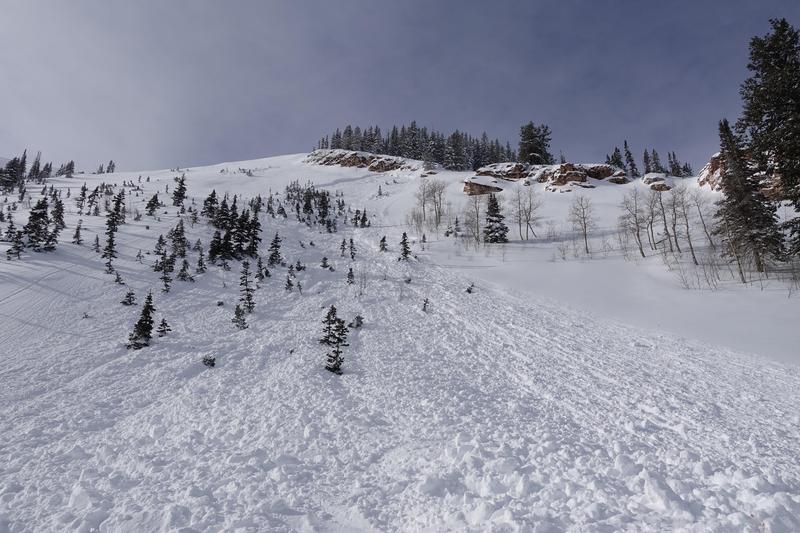
Terrain Summary
This slope was the scene of a fatal avalanche in February 2012. A nearby slope produced a fatal avalanche in January 2005.
The initial open slope off the ridge is about 30 degrees in steepness. It would appear to be relatively benign terrain to an advanced skier or snowboarder. The slope through the trees steepens to 32-35 degrees. Below the rock band where the avalanche happened, the slope steepens to 40 degrees. Based on vertical drop, the maximum speed of this avalanche would have been 45 mph.
Avalanche crown: 40.653466, -111.592653 (estimated from topographic maps and satellite imagery)
Burial location: 40.65400, -111.59055
Toe of Debris: 40.65439, -111.59003
Alpha angle: 30 degrees
The vertical drop of this slide was 460 ft and a slope distance of about 700 ft. Matt was carried approximately 400 vertical feet and a slope distance of 600 ft.
Map below from the Wasatch Backcountry Skiing Map
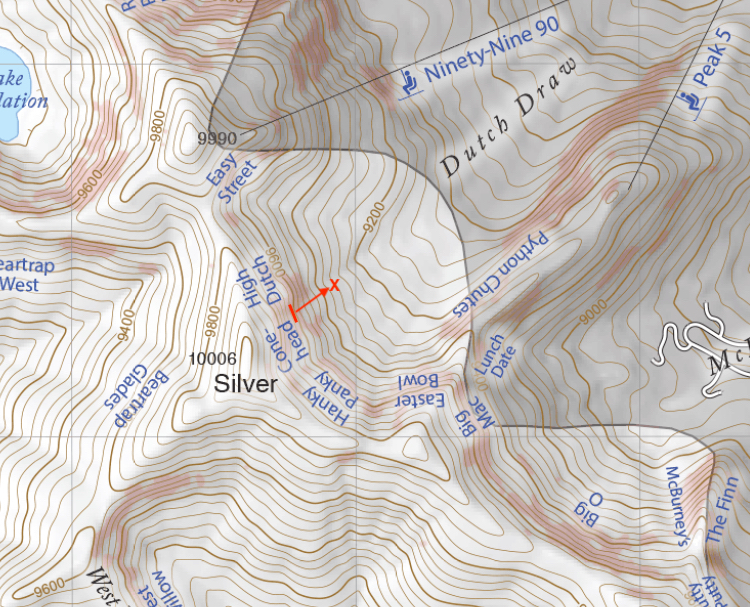
The short video below shows the view from the backcountry gate at the top of the 9990 chairlift. What would have looked different on Sunday morning is that you would have likely seen other people hiking and skiing/riding.
Weather Conditions and History
On the day of the accident, skies were mostly cloudy and winds were generally light and variable. Temperatures were in the single digits F. (source-9990 weather station).
From 12-14 December, a powerful Pacific storm impacted the Wasatch Mountains, snowing 18 inches (2.23 inches SWE-snow water equivalent) in the terrain adjacent to the accident site. Accompanying westerly winds had been light to moderate during the storm. During this storm, ski area avalanche professionals working at ski areas along the PC ridgeline (Park City and Canyons) triggered numerous new snow and older snow avalanches in similar terrain.
The Daybreak weather station (approx. 1 mile SE of avalanche) recorded the following total snow depth. Notice snow depth increases with each storm and decreases some as the new snow settles. The 9990 weather station (approx. 1/3 of a mile NNW of the accident) recorded winds.
The chart below shows snow depth since October to the accident.
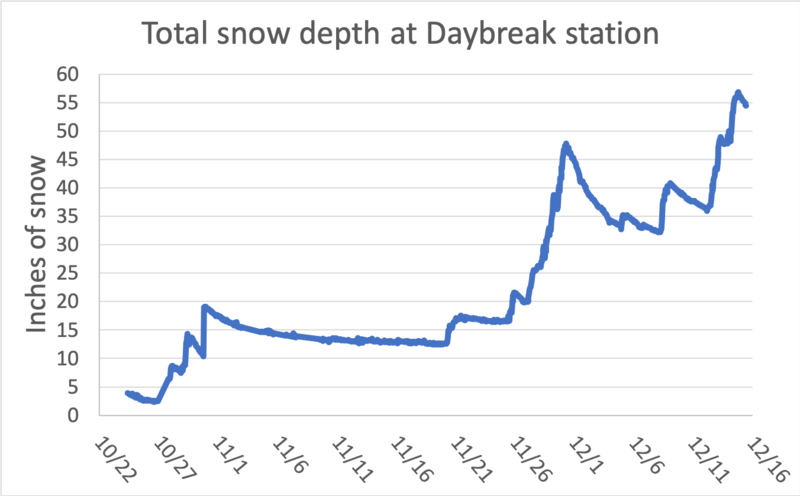
The chart shows total snow depth since the week of Thanksgiving to the accident.

The chart below shows the previous 4 days of winds.
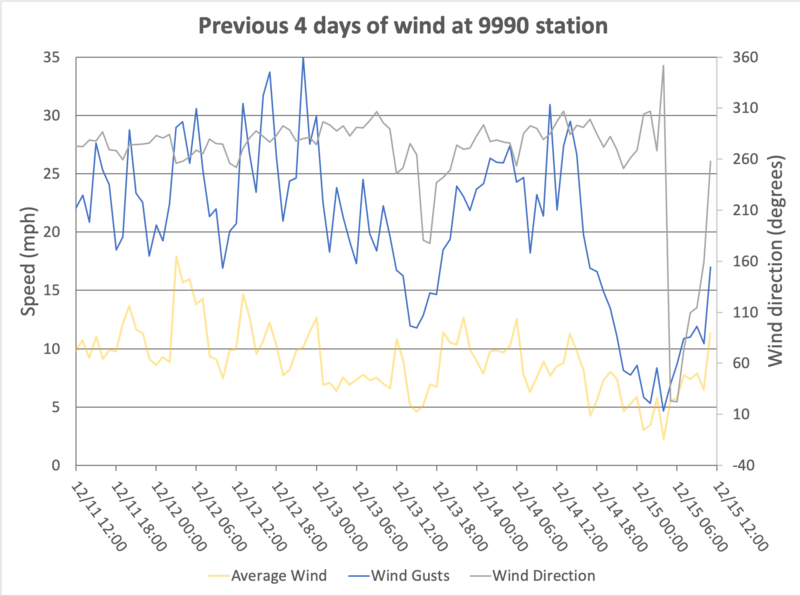
Comments
Snowpack
UAC staff was not able to access the crown face of the avalanche. We determined there was no safe way to approach the crown. In fact, the following day, Tuesday, Dec 17, a skier flying a speed wing triggered an avalanche on the same slope. This skier was able to use his wing to become airborne and avoid being caught in the slide.
Based on avalanches triggered by the ski patrol within their boundaries on Sunday, we think this avalanche was a soft slab of new snow. There may have been some wind drifting of the new snow blowing north to south and depositing additional snow just under the rock band where the avalanche occurred. We don't know what weak layer caused this slide. It may have simply been a poor bond underneath the new snow that fell December 12th-14th.
The photo below shows Tuesday's avalanche and obvious wind drifting of snow (photo - Park City Ski Patrol).
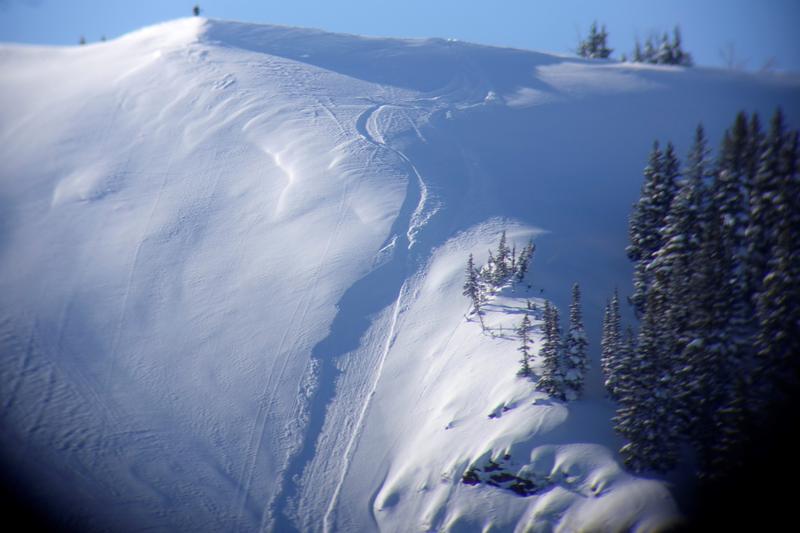
On Friday, December 12, an avalanche was spotted to the north. Because that crown had fully reloaded, we were not able to get a crown profile of that avalanche either.
Below is a photo showing that avalanche in relation to the fatal one (photo - Park City Ski Patrol).
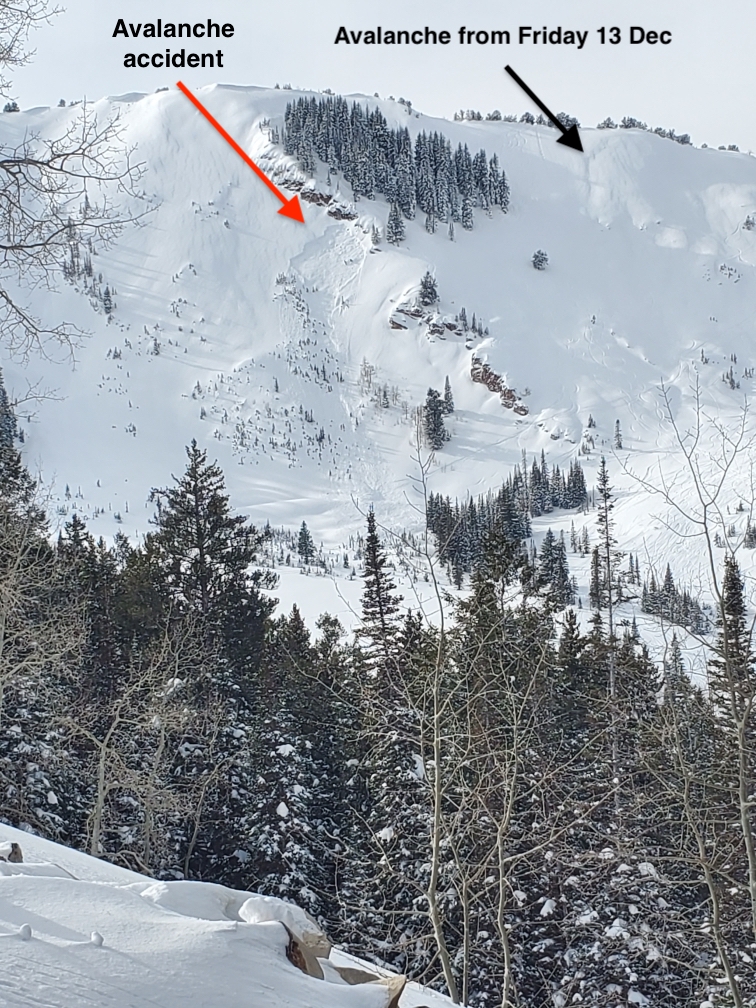
Avalanche Danger
During the brunt of the storms on Friday and Saturday, the avalanche danger was rated as HIGH in this terrain which is East-facing above 9500 feet in elevation. On the day of the accident, the avalanche danger was rated as CONSIDERABLE for this terrain. Sunday's avalanche forecast is available HERE. UAC Forecasters Trent Meisenheimer, Mark Staples and PCMR Snow Safety Manager Andy VanHouten visited the site on Monday, December 16.
Comments
We aim to learn from accidents like this and in no way intend to point fingers at victims. All of us at the Utah Avalanche Center have had our own close calls and know how easy it is to make mistakes. Our intention is for this report to offer a learning opportunity. For that reason we have the following comments.
(1) Avalanches are deadly and are similar to a bad car accident. Even a smaller avalanche like this can sweep you through trees the size of sign posts at 45 mph. One quarter of all avalanche vicitims die of trauma. When choosing slopes to ride, consider ones free of any trees or rocks in the runout zone.
(2) Going into the backcountry alone can be rewarding, but there is no margin for error. Even the smallest slides can be deadly if you don't have someone to find you and dig you out. Avalanche rescue gear helps us find your body, but a good partner can save your life. A small avalanche just north of this location killed a skier in February 2016 because he was skiing alone.
(3) There were other people skiing in Dutch Draw the day of the accident. Seeing other people enjoying powder without triggering avalanches has a strong affect on all of us. Unfortunately, snow is unforgiving and other tracks are not an indication that conditions are safe. There have been many accidents in which many people had ridden the slope that avalanched or adjacent ones without incident prior to the accident.
Our deepest condolences go out to the friends, family, rescuers, and everyone affected by this tragic accident.
Coordinates






